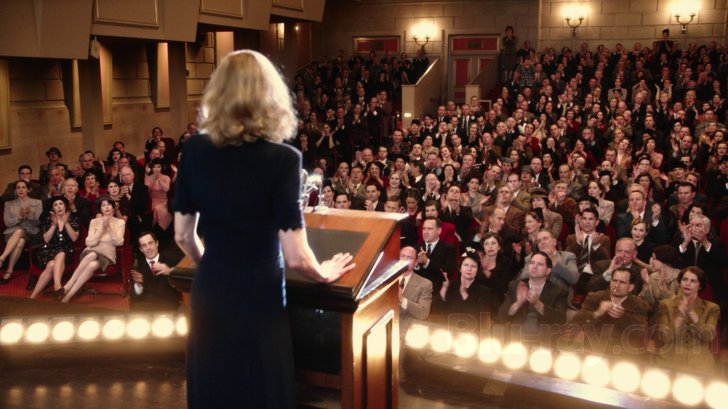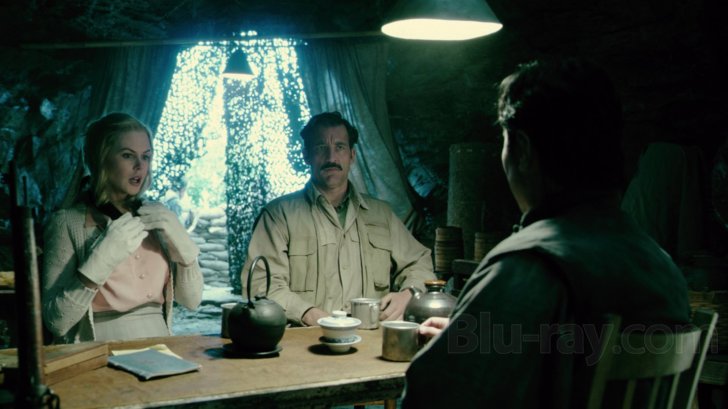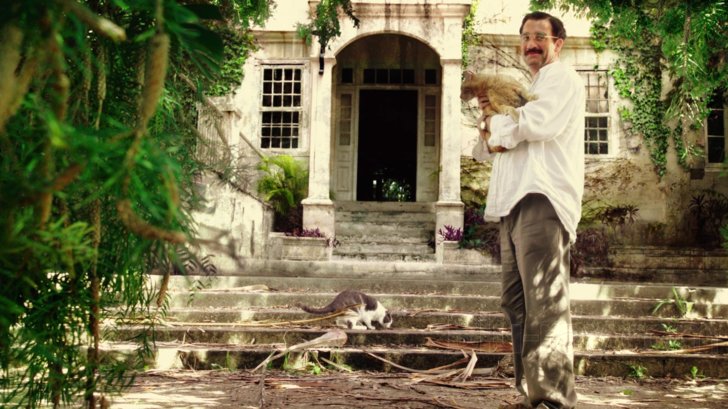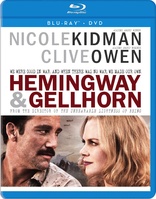Hemingway & Gellhorn Blu-ray Movie
HomeHemingway & Gellhorn Blu-ray Movie 
HBO | 2012 | 155 min | Rated TV-MA | Apr 02, 2013Movie rating
6.4 | / 10 |
Blu-ray rating
| Users | 0.0 | |
| Reviewer | 4.5 | |
| Overall | 4.5 |
Overview
Hemingway & Gellhorn (2012)
A drama based on the romance between Ernest Hemingway and war correspondent Martha Gellhorn, who helped inspire Hemingway's novel For Whom the Bell Tolls, and the only one of the writer's four wives to ask him for a divorce.
Starring: Nicole Kidman, Clive Owen, David Strathairn, Rodrigo Santoro, Molly ParkerDirector: Philip Kaufman
| Drama | Uncertain |
| Romance | Uncertain |
| Biography | Uncertain |
Specifications
Video
Video codec: MPEG-4 AVC
Video resolution: 1080p
Aspect ratio: 1.78:1
Original aspect ratio: 1.78:1
Audio
English: DTS-HD Master Audio 5.1 (48kHz, 16-bit)
French: DTS 5.1 (48kHz, 16-bit)
Spanish: DTS 2.0
Subtitles
English SDH, French, Spanish
Discs
50GB Blu-ray Disc
Two-disc set (1 BD, 1 DVD)
Playback
Region free
Review
Rating summary
| Movie | 4.5 | |
| Video | 5.0 | |
| Audio | 5.0 | |
| Extras | 2.5 | |
| Overall | 4.5 |
Hemingway & Gellhorn Blu-ray Movie Review
No Farewell to Arms
Reviewed by Michael Reuben March 30, 2013One's ability to enjoy director Philp Kaufman's HBO original movie Hemingway & Gellhorn greatly depends on one's tolerance for characters who make grand pronouncements and take themselves with utter seriousness. Contemporary viewers often balk at accepting such characters unless they're cloaked in an alternate reality that puts them at a comfortable distance—the remote past or perhaps a fantasy world such as Middle Earth or a galaxy far, far away. Should anyone of that nature pop up today, the immediate assumption is that they're a fraud, a pitchman or, worst of all, a politician. Still, it wasn't so long ago that such people lived, worked and drew huge audiences without the aid of spin or publicists. Nobel Prize-winning author Ernest Hemingway was one of them, and so was his third wife, war correspondent Martha Gellhorn. Gellhorn was the only one of Hemingway's four wives to maintain her own career. As both mutual admirers and fierce competitors, the two were briefly a celebrity couple in the 1940s, until, like many celebrity couples, ambition split them apart. Hemingway died of a self-inflicted gunshot wound in 1961 at the age of 61, whereas Gellhorn continued working well into her 80s. She died in 1998 of a drug overdose, after a long battle with cancer. As a condition of giving interviews, she would often insist that no questions about Hemingway be asked, saying that she did not wish to be a "footnote in someone else's life". (The line appears near the end of Kaufman's film.) Hemingway & Gellhorn is the result of years of painstaking research, not only in writings, letters and journals by and about the two writers, but also in film archives around the world. Using the latest digital technology, and without ever leaving the San Francisco Bay area, the production has seamlessly recreated a compelling story of two larger-than-life personalities whose collisions played themselves out against a background of cataclysmic events around the world. You don't get a literary education from Kaufman's film; for that, you'd have to read For Whom the Bell Tolls, the novel that Hemingway wrote during the period portrayed in the film and dedicated to Gellhorn. Nor do you get a clear understanding of the history of the Spanish Civil War, the invasion of Normandy or any of the various theaters of World War II on which Gellhorn reported; for that, you'd have to read her dispatches or the history books that have used them as source material. What you do get is a sense of two exceptional, frequently difficult, sometimes dislikeable people, who had the drive to accomplish things that others couldn't and were willing to sacrifice everything in the process, including each other.

Gellhorn (Nicole Kidman) narrates the film as an elderly lady who gazes without blinking into an interviewer's camera. (The makeup that ages Nicole Kidman is the most convincing disguise I've seen since her Oscar-winning appearance as Virginia Woolf in The Hours.) Though American by birth, Gellhorn has lived in Britain for many years by this point and has acquired a slight English accent. Her voice has deepened from a lifetime of cigarette consumption. Establishing the distinctive tone of the older Gellhorn's voice is crucial to guiding the viewer through the film's shifting time periods and voiceovers, because the younger Gellhorn sometimes chimes in, reading her dispatches from the front. Gellhorn meets Hemingway (Clive Owen) in 1936 in Sloppy Joe's bar in Key West, Florida, where she is visiting with her mother and brother. At the time, Hemingway is married to his second wife, Pauline (Molly Parker), with whom he has two sons, but he is always surrounded by a coterie of male friends, who, in the film, are represented by former bullfighter Sidney Franklin (Saverio Guerra). In this era, it is still possible for a serious author to become a celebrity, and currently at the height of his fame, Hemingway is enjoying the notoriety of a rock star. As aptly illustrated in the script by Jerry Stahl and Barbara Turner and faithfully portrayed by Owen, Hemingway's attitude toward his own public image is contradictory. He loves the spotlight, especially when it helps him attract beautiful women, but he also understands that fame is fleeting and ultimately unreliable. Hemingway and Gellhorn reconnect the following year in Madrid, where Martha has gone to report on the Spanish Civil War for Collier's magazine. Hemingway was there supposedly as a reporter, but increasingly he becomes involved with a documentary film project by Dutch director Joris Ivens (Lars Ulrich) supported by American author John Dos Passos (David Straithairn). A motley crew of anti-Franco sympathizers end up staying at the same hotel, where their interactions are, by turns, comical, dangerous and sinister (the last quality being the special province of a Russian journalist, Koltsov, played by Tony Shalhoub). As their circumstances turn ever more perilous, the attraction between Hemingway and Gellhorn grows, and they become lovers. The film follows the couple as they split and reunite across three continents and the island of Cuba, where they acquire a house called Finca Vigia. But Gellhorn has the adrenaline junkie's need to be where the action is. Instead of staying in Cuba with Hemingway while he is writing For Whom the Bell Tolls, she flies off to cover the war in Finland, where the Russians are invading. When she returns, Hemingway announces that he has divorced Pauline and proposes marriage, but for a honeymoon, Gellhorn insists on visiting China to cover the war between the forces of Chiang Kai-shek and the communists. With the greatest reluctance, Hemingway accompanies her. Later, he has himself hired by Collier's to cover D-Day, just so that Gellhorn cannot. She finds a way to get there anyway. Hemingway's feuds with other male writers were legendary. At one point, Pauline refers to his rivalry with F. Scott Fitzgerald; the cruelty that Hemingway displayed toward Dos Passos is repeatedly shown in the film; and a famous incident involving a fistfight with the critic Max Eastman (Mark Pellegrino) is enacted in all its ridiculous detail. But no female writer ever gave Hemingway a run for his money the way Martha Gellhorn did, and at least in this interpretation, it is more than he can handle. When Gellhorn demands a divorce in 1944, Hemingway goes back to his old habits and marries another caretaker, Mary (Parker Posey), his fourth and final wife. In an overly rushed conclusion, Hemingway & Gellhorn compresses the sixteen years following the couple's divorce into a few minutes, as if Hemingway's productive life ended after he split from Gellhorn. (It didn't.) Owen's portrayal of Hemingway treads a fine line between a realistic character and the iconic figure that the author himself deliberately cultivated after he became well-known. (One review at the time of the film's release mocked the script for having a husband address his wife as "Gellhorn", but the real Hemingway was well known for such eccentricities.) As Gellhorn, Kidman has more room to maneuver, because her character is less familiar, but she also has the more difficult job of making comprehensible a woman who was unique, not just for her time, but in general. In his commentary, Kaufman expresses the hope that both scholars and the public will now reevaluate Gellhorn and her achievements. Hemingway & Gellhorn is an excellent beginning.
Hemingway & Gellhorn Blu-ray Movie, Video Quality 

Photographed with the Arri Alexa by Rogier Stoffers, the Dutch cinematographer who shot director Kaufman's Quills, Hemingway & Gellhorn owes its final appearance to post-production manipulation even more than most contemporary films, as a result not only of the digital trickery that inserts the actors into archival footage, but also of the constant shifts in palettes and appearance. Each locale has a distinctive color scheme, and editor Walter Murch constantly modulates between a contemporary "you-are-there" style and a historical, "old newsreel" look, complete with scratches and print damage. HBO's 1080p, AVC-encoded Blu-ray accurately captures these shifts, which is to say that the contemporary footage is colorful and detailed, and you're much more aware of both qualities when they reappear after having been leeched out of the image digitally for the historical look. Black levels and contrast are accurate, and the only artifacts in the picture are those that have been deliberately placed there to simulate aging or damaged film. In numerous respects, the image on Hemingway & Gellhorn is a tribute to the capabilities of digital cinema to replicate—and even extend—the capabilities of film. The work of Kaufman and his collaborators on this project should be taught in film schools.
Hemingway & Gellhorn Blu-ray Movie, Audio Quality 

Hemingway & Gellhorn won well-deserved Emmy Awards for its soulful score by composer Javier Naverrete (Pan's Labyrinth) and for its elaborate sound editing. Both are thrillingly represented on the Blu-ray's DTS-HD MA 5.1 track. The sound editors have carefully coordinated their work to match Murch's editing choices. Listen, for example, to the forceful impact with which Hemingway strikes the death blow to a huge fish he lands in his opening scene, which provides a key transition to his first meeting with Gellhorn. Sound effects specific to each of the film's exotic environments have been deftly woven throughout, and often amplified for special emphasis; a notable example is the Hemingways' meeting with General and Mrs. Chiang Kai-shek (Larry Tse and Joan Chen), where the noises of the General's dining habits are more noteworthy than anything he says (which isn't much). Of course, the wartime sounds are the most dramatic, and the aerial bombardment of Madrid by Franco's forces registers with tremendous impact, especially for systems equipped with a subwoofer. However, the quality of the sound editing is revealed by how little the experience resembles an action film sequence. The impacts are abrupt, sharp and unnerving. There is nothing "thrilling" about them. The same is true of every scene relating to war. Equally fine sound work can be heard in the Hemingway home in Cuba, where cats are always howling; in the editing room in New York where Ulrich's documentary film is completed (and Hemingway fires Orson Welles as the film's narrator); and at the party following the film's premiere, where Hemingway gets into a fight with a critic. Every one of these environments has been sonically reconstructed. Meanwhile, the dialogue and voiceovers remain clear and distinct, and Naverrete's score casts its spell over the entire affair.
Hemingway & Gellhorn Blu-ray Movie, Special Features and Extras 

- Commentary with Director Philip Kaufman and Editor Walter Murch: Kaufman dominates this commentary, which is relaxed and laconic, with frequent pauses between comments. By and large, Kaufman keys his remarks to the action on screen, but along the way he drops informative details about source materials, locations, working with the actors and the contributions of the digital artists.
- Behind the Visual Effects (1080i; 1.78:1; 5:29): This series of shots in various stages of completion (plates, partial composites, finished) provides an insight into the full extent of the elaborate digital artistry that allowed a film of this scale to be created on a budget of less than $20 million.
- Making Hemingway & Gellhorn (1080i; 1.78:1; 6:27): This short featurette provides essential background on the genesis of the project, which grew out of a chance encounter between Kaufman and Kidman. Interviewees include the director and his two leads, as well as effects supervisor Chris Morley.
- Trailer: At startup, the disc plays a trailer for HBO original films and miniseries, which can be skipped with the chapter forward button and is not otherwise available once the disc loads.
Hemingway & Gellhorn Blu-ray Movie, Overall Score and Recommendation 

Digital effects have advanced by leaps and bounds since Robert Zemeckis had Tom Hanks interact with former U.S. Presidents in Forrest Gump (1994). Those sequences appear primitive by comparison to what Kaufman has achieved in Hemingway & Gellhorn. Just compare the sequence in which Clive Owen and Nicole Kidman meet with President and Mrs. Roosevelt for an obvious example. Kaufman began experimenting with such techniques as early as The Right Stuff (which appeared in 1983, the same year as Woody Allen's Zelig, another early example) and The Unbearable Lightness of Being (1988), but his latest project breaks new ground in the recreation of past events. For both the story and the way it has been told, highly recommended.
Similar titles
Similar titles you might also like

A Matador's Mistress
Manolete
2008

There Be Dragons
2011

The Kite Runner
2007

Nixon
Election Year Edition
1995

To Kill a King
2003

Désirée
Limited Edition to 3000 - SOLD OUT
1954

Mao's Last Dancer
2009

Churchill
2017

In the Land of Blood and Honey
2011

Mr. Selfridge: The Complete Second Season
Original UK Edition
2013

The Way We Were 4K
50th Anniversary
1973

Frida
2002

Lee Daniels' The Butler
2013

Young Mr. Lincoln
1939

Seven Years in Tibet
1997

The Sand Pebbles
1966

Shanghai Express
1932

Diana
2013

The Remains of the Day 4K
30th Anniversary Edition
1993

Antwone Fisher
2002
